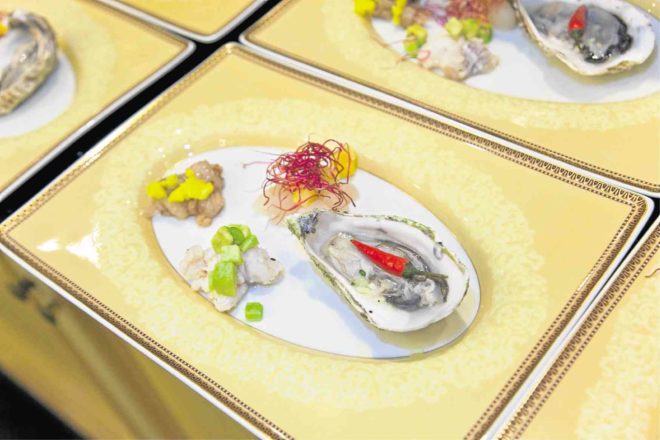
Germany was the last leg of the cultural diplomacy program of the Department of Foreign Affairs’ “Kulinarya: A Culinary Tour with Chef Myrna Segismundo.”
Yet this wind-up was not like a drama dénouement but more of a climax. It was also an example of how Filipino food can be showcased in a formal affair like a diplomatic dinner or a vin d’honneur.
Philippine Ambassador to Germany Melita Sta. Maria-Thomeczek decided that this last dinner would be in celebration of Philippine Independence. The venue, Hotel Maritiim Berlin’s Brasserie, was arranged formally with each table labeled not by numbers but with the names of some of the Philippine islands.
Guests, as expected, were from the diplomatic corps, heads of business groups and prominent Filipinos in the German community.
The chefs—Segismundo, Jill Sandique and Raul Ramos—
had done the preparations at the hotel’s first floor kitchen for two days. But on the day itself, work moved up to the Brasserie’s open kitchen where the cooking and plating took place. The formal plates added pizzazz to the presentation, with wines paired instead of cocktails in the London, Brussels and The Hague editions.
Mango-‘lambanog’
But those cocktails enlivened the mood at the lobby as guests lined up for mango-lambanog and rum-coke while partaking of chicken inasal and adobo pâté.
And what is a Filipino party without music? Singer Jonathan Zaens and pianist Dr. Abelardo Galang Jr. rendered two numbers, a German classic and a Filipino pop standard, “Sana’y Wala Nang Wakas.”
Germany was different from the other places because the program involved two cities. While the dinner was in Berlin, the exhibit, talk and cooking demonstration were held in Hamburg, 250 kilometers or three hours away.
As in The Hague, a hotel management school, Hotelfachshule was utilized. The embassy team—Alvin Malasig, third secretary and vice consul, and Mylah Rubio, cultural attaché—which facilitated the dinner also managed this phase.
Hamburg
Hamburg is a port city and this was where the seafood for the dinner came from. At the local market there were large whole cods.
The market is in the area known as Turkey town, where vegetables were huge and fruits fresh and plentiful. The Kulinarya team also had to visit a Chinese grocery, which was the only source of Asian ingredients.
The Hamburg session was likewise different because, apart from the adobo pâté, chicken and pork adobo with rice and bok choy were served, so that the students and faculty could taste both adobo versions. It demonstrated as well that adobo is a way of cooking, and not a dish.
The lambanog and rum cocktails easily appealed to the young students. We hope they heard the message that the Philippines now produces top- quality and award-winning coconut vodka and rum.
One of the chefs who attended the Berlin dinner wanted to share with his students the flavors and ingredients of Filipino cuisine. This was at the Brillat-Savarin-Schule, the biggest vocation school focusing on the hotel and hospitality industry. Segismundo delivered the talk from the viewpoint of a veteran to aspiring chefs.

‘Hidden Flavors’
While the Kulinarya tour ended the last week of June, another one is brewing in North America.
Amy Besa and chef Romy Dorotan who own Purple Yam in Brooklyn and Malate, Manila, will do the rounds of New York, Seattle, Chicago, Toronto and Philadephia from Sept. 15 to Oct. 10, with chefs Raphael Cristobal and Alvin Ralph Cruz. The tour will highlight the “Hidden Flavors of the Philippine Kitchen,” said Besa.
The “hidden flavors” come from ingredients, many not typical in everyday Filipino cooking and, more often than not, can be found only in specific regions of the country.
At a press conference in Purple Yam Malate just before the European tour, there was etag, the salted pork of Sagada in the Cordilleras that was stewed with Kalinga beans and tomato sarsa (sauce).
The vegetable fried rice will use tinowan, an heirloom rice also from the Cordilleras. The pancit sotanghon will have a sauce combining coffee and coconut milk.
The adobo version will have turmeric (dilaw), which is the way adobo is done in Taal, Batangas.
And for starters, the team will use cab-cab, thin crackers made with cassava that is a specialty in Camiguin, Bohol and Leyte, with a topping of Bicol express, green chili cooked in coconut milk.
The two culinary diplomacy tours may differ in approach, but both teams highlight Filipino ingredients and produce and how we have preserved them through various ways of cooking.
E-mail the columnist at [email protected].









































